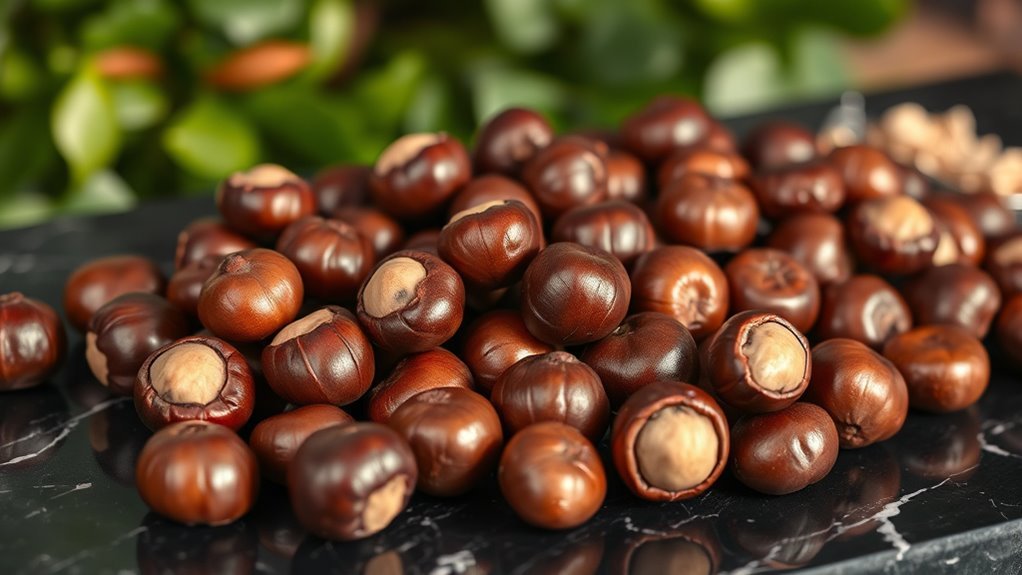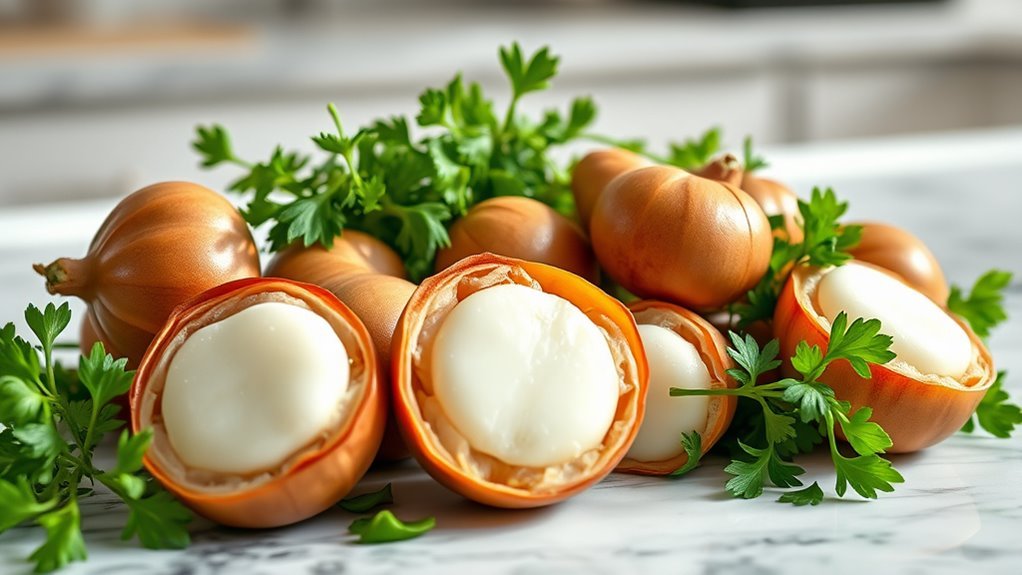Water chestnuts aren’t typically considered keto-friendly due to their carbohydrate content. With around 24 grams of carbohydrates per cup, they can disrupt strict ketosis. While they’re high in fiber and provide various health benefits, it’s crucial to monitor your carb intake closely. If you’re following a ketogenic diet, consider alternatives like zucchini or cauliflower for lower-carb options. For more insights on incorporating these vegetables into your diet, keep exploring your choices.
Understanding Water Chestnuts

Water chestnuts, despite their name, aren’t actually nuts but rather aquatic tubers that grow in marshy environments. Understanding water chestnuts requires exploring their varieties and cultivation methods. Common water chestnut varieties include the Chinese water chestnut and the Japanese water chestnut, each offering unique textures and flavors. Cultivation typically involves planting tubers in nutrient-rich, shallow water, allowing them to thrive in warm climates. Farmers often utilize specific techniques to maximize yield, such as maintaining ideal water levels and controlling pests. This knowledge can empower you to appreciate the versatility of water chestnuts in culinary applications, as well as their significance in sustainable agriculture. By understanding these aspects, you can make informed choices about incorporating them into your diet.
Nutritional Profile of Water Chestnuts

The nutritional profile of water chestnuts makes them an intriguing addition to a balanced diet. Rich in nutrient density, these crunchy vegetables provide essential vitamins and minerals with minimal calories. They’re particularly known for their high water content, which helps keep you hydrated while adding volume to your meals without excess calories. Water chestnuts are a good source of potassium, which supports heart health, and their fiber content aids digestion. They’re low in fat, making them an excellent choice for those seeking a lighter option. By incorporating water chestnuts into your meals, you can enjoy a versatile ingredient that not only boosts your nutrient intake but also enhances the texture and flavor of your dishes.
Carbohydrate Content

Although you might think of water chestnuts as a low-carb option, their carbohydrate content is worth examining more closely, especially for those following a ketogenic diet. Water chestnuts contain around 24 grams of carbohydrates per cup, which can greatly impact your daily limit if you’re adhering to strict keto guidelines. While they’re a unique vegetable and can add crunch to meals, they may not align with your goals if you’re focusing on lower carbohydrate sources. For a successful keto journey, it’s vital to prioritize foods that stay within your carb limits. So, if you’re considering water chestnuts, keep a close eye on your overall intake to maintain that desired state of ketosis and guarantee you’re making choices that empower your dietary freedom.
Fiber Content and Its Importance
While many people focus on carbohydrate content when considering foods for a ketogenic diet, fiber content is equally important, particularly when evaluating water chestnuts. Water chestnuts provide a unique combination of fiber sources that can enhance your diet. They contain about 3 grams of fiber per 100 grams, which supports digestive health and helps maintain steady blood sugar levels.
Incorporating fiber-rich foods like water chestnuts can yield numerous health benefits, such as improved satiety and reduced cravings, ultimately aiding in weight management. Additionally, fiber plays a vital role in gut health, promoting a balanced microbiome. So, while you’re counting carbs, don’t overlook the importance of fiber; it’s essential for overall well-being and can complement your ketogenic lifestyle effectively.
Comparing Water Chestnuts to Other Vegetables
When you compare water chestnuts to other vegetables, you’ll notice distinct differences in their nutritional profiles and carbohydrate content. While many vegetables are low in carbs, water chestnuts stand out with their unique texture and slightly higher carb levels, making them a notable choice for certain diets. Understanding these differences can help you make informed decisions about incorporating various vegetables into your keto plan.
Nutritional Profile Comparison
Water chestnuts, often overlooked in discussions of vegetable nutrition, offer a unique profile that can be quite different from other commonly consumed vegetables. Their nutrient density is notable, especially for those with dietary restrictions. Here’s a quick comparison:
| Vegetable | Calories per 100g | Fiber (g) | Vitamin C (%) |
|---|---|---|---|
| Water Chestnuts | 97 | 3.0 | 8 |
| Broccoli | 34 | 2.6 | 89 |
| Carrots | 41 | 2.8 | 9 |
| Spinach | 23 | 2.2 | 47 |
As you can see, water chestnuts provide a higher calorie count but also a distinct crunch and versatility that can satisfy cravings while accommodating various dietary needs.
Carb Content Analysis
Understanding the carbohydrate content in various vegetables is vital for those following a ketogenic diet, where carb intake is strictly monitored. Water chestnuts, often praised for their crunch, contain about 24 grams of carbs per 100 grams, which exceeds the keto diet guidelines for daily intake. In comparison, leafy greens like spinach or kale have notably lower carb counts, making them more suitable choices for keto followers. While water chestnut cultivation can provide a unique texture to dishes, their higher carb content may hinder your progress on a keto plan. It’s important to explore alternatives that align better with your dietary goals, ensuring you maintain the freedom to enjoy a variety of flavors without compromising your carb limits.
Health Benefits of Water Chestnuts
Water chestnuts offer a unique nutritional profile that can complement your keto diet. Rich in antioxidants, they help combat oxidative stress while also promoting digestive health through their fiber content. By incorporating water chestnuts into your meals, you’re not just adding texture but also enhancing your overall well-being.
Nutritional Profile Overview
Although often overlooked, water chestnuts offer a unique nutritional profile that can contribute to a balanced diet, especially for those following a keto lifestyle. These crunchy tubers, available in several water chestnut varieties, are low in calories and high in fiber, making them an excellent choice for those seeking to manage their weight. With about 60 calories per cup, they also provide essential nutrients like potassium and vitamin B6. Their culinary uses are diverse; you can add them to stir-fries, salads, or simply enjoy them as a snack. By incorporating water chestnuts into your meals, you can enhance flavor and texture while maintaining a low-carb approach, aligning perfectly with the principles of the ketogenic diet.
Antioxidant Properties Explained
While many might not realize it, water chestnuts are packed with antioxidants that can play a significant role in promoting health. These antioxidants, such as flavonoids and phenolic compounds, offer various health benefits by neutralizing free radicals in your body. This can lead to reduced oxidative stress, which is linked to chronic diseases like heart disease and cancer. By incorporating water chestnuts into your diet, you’re not only adding a crunchy texture but also enhancing your overall antioxidant intake. Research suggests that regular consumption of antioxidant-rich foods can positively impact your health, supporting your body’s natural defenses. So, if you’re looking for a tasty way to boost your health, consider the antioxidant benefits of water chestnuts.
Digestive Health Benefits
Incorporating water chestnuts into your diet can greatly benefit your digestive health, thanks to their high fiber content. Fiber is essential for maintaining regular bowel movements and preventing constipation. Additionally, water chestnuts offer probiotic benefits, which can enhance gut health by fostering a balanced microbiome. A healthy gut is vital for nutrient absorption and overall wellness, allowing your body to thrive. The unique texture and crunch of water chestnuts make them a versatile addition to various dishes, ensuring you can enjoy their health benefits without sacrificing flavor. By making water chestnuts a staple in your meals, you’re actively supporting your digestive system and promoting a healthier lifestyle. Embrace the freedom of choice in your diet and enjoy the perks water chestnuts offer!
How to Incorporate Water Chestnuts Into Your Meals
When you’re looking to add variety to your keto meals, water chestnuts can be a versatile ingredient that enhances both texture and flavor. Their crunchy texture makes them an excellent addition to water chestnut stir fry, providing a satisfying bite that complements other vegetables and proteins. You can easily sauté them with garlic and soy sauce for a quick dish that fits your dietary needs. Additionally, try incorporating water chestnuts into water chestnut salads; their mild flavor pairs well with crunchy greens and tangy dressings. Whether you’re tossing them into a bowl or stir-frying, water chestnuts offer a unique way to stay on track with your keto lifestyle while enjoying diverse and exciting meals.
Alternatives to Water Chestnuts on a Keto Diet
If you’re looking for low-carb vegetable options that can replace water chestnuts on a keto diet, consider alternatives like zucchini or radishes. These choices not only provide a similar crunch but also fit well within your carb limits. Additionally, for a satisfying snack, try kale chips or celery sticks as they can mimic the texture while keeping your meals aligned with keto principles.
Low-Carb Vegetable Options
Although water chestnuts are often praised for their crunchy texture and low-carb profile, there are several other vegetables that can serve as excellent alternatives on a keto diet. Cauliflower is a popular choice, offering versatility as a low-carb substitute for rice or mashed potatoes. Zucchini, another great option, can be spiralized into noodles, providing a satisfying, low-carb base for your meals. Additionally, radishes bring a peppery crunch and can be roasted or used in salads. Other vegetable varieties, like asparagus and bell peppers, also fit well within a keto framework, delivering essential nutrients without the carbs. By incorporating these low-carb substitutes, you can enjoy diverse flavors while staying true to your keto lifestyle.
Crunchy Snack Alternatives
While water chestnuts offer a satisfying crunch, several other keto-friendly snacks can deliver a similar texture without the carbs. Embracing these crunchy alternatives allows you to maintain your diet while still enjoying satisfying bites. Here are three options to contemplate:
- Celery Sticks: Low in calories and high in fiber, celery offers a invigorating crunch that pairs well with dips.
- Radishes: With a peppery bite and crisp texture, radishes can be roasted or eaten raw, making them versatile and delicious.
- Cucumber Slices: Hydrating and crunchy, cucumbers are perfect for snacking and can be seasoned to enhance their flavor.
Exploring these alternatives not only satisfies your cravings but also aligns with your keto lifestyle, giving you the freedom to enjoy healthy snacking.
Tips for Tracking Carbohydrates
How can you effectively track carbohydrates on a keto diet? Start with carb counting, as it’s essential for keeping your daily intake in check. Use a food journal or a tracking app; both can simplify meal planning and help you stay accountable. When preparing meals, measure ingredients and look up carb content to verify accuracy. Don’t forget to account for hidden carbs in sauces or processed foods. Aiming for low-carb vegetables can also enhance your meals without exceeding your limits. Finally, review your progress regularly. This helps you adjust as needed and allows for flexibility in your eating habits. Remember, tracking isn’t just about restriction; it’s a tool that gives you the freedom to enjoy a diverse range of keto-friendly foods.
Final Thoughts on Water Chestnuts and Keto
As you navigate the keto diet, incorporating water chestnuts can be a strategic choice worth considering. Their unique benefits align with your goals for health and well-being. Here are three compelling reasons to include them:
- Low in Carbs: Water chestnuts are relatively low in carbohydrates, making them keto diet compatible.
- Nutrient-Dense: Packed with vitamins and minerals, they contribute to overall nutrition without derailing your macros.
- Crispy Texture: Their crunchy texture adds variety to your meals, enhancing your culinary experience.
Frequently Asked Questions
Can Water Chestnuts Be Eaten Raw on a Keto Diet?
Picture biting into a crisp, invigorating water chestnut—its crunch echoing like a revitalizing splash in a tranquil pond. When it comes to raw consumption, you can enjoy water chestnuts, as they’re low in carbs and can fit into a keto diet. They offer keto benefits, including fiber and essential nutrients that promote satiety. Just remember to balance them with other low-carb foods to maintain your desired macros while enjoying their delightful texture.
Are Canned Water Chestnuts Keto-Friendly?
Canned water chestnuts can be keto-friendly, depending on your overall carb intake. They’re low in calories and carbohydrates, offering nutritional benefits like fiber and vitamins. You can enjoy them raw, sautéed, or added to stir-fries, enhancing your meals without kicking you out of ketosis. Just check for added sugars in canned varieties. Balancing their use with other low-carb ingredients allows you to savor their crunch while maintaining your dietary freedom.
Do Water Chestnuts Have Any Allergens?
Did you know that about 2% of the population experiences allergic reactions to various foods? When it comes to water chestnuts, they’re generally considered hypoallergenic, meaning they rarely trigger allergies. Their nutritional content is mainly carbohydrates, with minimal proteins and fats, making them a safe choice for most. However, if you have a specific allergy or sensitivity, it’s always wise to consult with a healthcare professional before adding new foods to your diet.
How Should Water Chestnuts Be Stored?
To store water chestnuts effectively, keep ’em in a cool, dry place. If you’ve opened a can, refrigerate any leftovers in an airtight container. Fresh water chestnuts should be submerged in water and stored in the fridge, changing the water every few days. This preserves their crunchiness, making ’em perfect for water chestnut recipes. Plus, their nutritional benefits, like fiber and antioxidants, make them a great addition to your meals.
Can Water Chestnuts Be Frozen?
Imagine you’re prepping a stir-fry and have leftover water chestnuts. Can you freeze them? Absolutely! To preserve their crunch, blanch them first. This freezing method helps maintain texture and flavor. After blanching for about three minutes, quickly cool them in ice water, then drain and pack them into airtight containers. For ideal storage, label them with the freezing date. With these tips, you can enjoy water chestnuts long after your initial meal!


